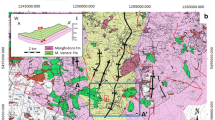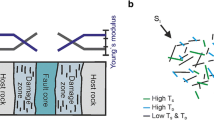Abstract
Surface fractures in the overburdened sedimentary rocks, formed above a deep-seated basement fault, often provide important information about the kinematics of the underlying master fault. It has already been established that these surface fractures dynamically evolve and link one another with progressive displacement on the master fault below. In the present study, two different series of riedel-type experiments were carried out with clay analogue models under different boundary conditions viz., (i) heterogeneous simple shear of the cover rocks above a buried strike slip fault (wrench system) and (ii) heterogeneous simple shear with a component of shear-normal compression of the overburden package above a basement fault (transpressional system), to observe the initiation and linkage of surface fractures with varying T′ (where T′ = thickness of the overburden normalized with respect to the width of the master fault). In the wrench system, Riedel (R) shears were linked by principal displacement (Y) shears at early stages (shear strain of 0.8 to 1) in thin (2 < T′ < 18) models and finally (at a minimum shear strain of 1.4) gave rise to a through-going fault parallel to the basement fault without development of any other fracture. Conjugate Riedel (R′) shears develop only within the thicker (T′ > 18) clay models at a minimum shear strain of 0.7. With increasing deformation (at a minimum shear strain of 1.2) two R′ shears were joined by an R shear and finally opened up to make a sigmoidal vein with an asymmetry antithetic to the major fault-movement sense. Under transpression, the results were similar to that of heterogeneous simple shear for layers 2 < T′ < 15. In layers of intermediate thickness (15 < T′ < 25) early formed high angle R shears were cross cut by low angle R shears (at a minimum shear strain of 0.5 and shortening of 0.028) and “Riedel-within-Riedel” shears were formed within thick (T′ > 25) models (at minimum shear strain of 0.7 and shortening of 0.1), with marked angularity of secondary fault zone with the master fault at depth.
Similar content being viewed by others
References
Ahlgren S G 2001 The nucleation and evolution of Riedel shear zones as deformation bands in porous sandstone; J. Struct. Geol. 23 1203–1214.
Atmaoui N, Nina K, Bernhard S and Diethard K 2006 Initiation and development of pull-apart basins with Riedel shear mechanism: insights from scaled clay experiments; Int. J. Earth Sci. 95 225–238.
Bartlett W L, Friedman M and Logan J M 1981 Experimental folding and faulting of rocks under confined pressure. Part IX. Wrench faults in limestone layers; Tectonophys. 79 255–277.
Coelho S, Passchier C and Marques F 2006 Riedel-shear control on the development of pennant veins: Field example and analogue modeling; J. Struct. Geol. 28 1658–1669.
Davis G H, Bump A P, Garcia P E and Ahlgren S G 1999 Conjugate Riedel deformation band shear zones; J. Struct. Geol. 22 169–190.
Erdlac R J and Anderson T H Jr 1982 The Chixoy-Polochic fault and its associated fractures in western Guatemala; Geol. Soc. Amer. Bull. 93 57–67.
Gammond J F 1983 Displacement features associated with fault zones: a comparison between observed examples and experimental models; J. Struct. Geol. 5 33–45.
Katz Y, Weinberger R and Aydin A 2004 Geometry and kinematic evolution of Riedel shear structures, Capitol Reef National Park, Utah; J. Struct. Geol. 26 491–501.
Kim Y S, Peacock D C P and Sanderson D J 2003 Mesoscale strike-slip faults and damage zones at Marsalforn, Gozo Island, Malta; J. Struct. Geol. 25 793–812.
Marques F O 2001 Flow and fracturing of clay: analogue experiments in pure shear; Tectonic Modeling: A volume in Honor of Hans Ramberg; Geol. Soc. Amer. Bull. Memoir 193 261–270.
Naylor M A, Mandl G and Sijpesteijn C H K 1986 Fault geometries in basement-induced wrench faulting under different initial stress states; J. Struct. Geol. 8 737–752.
Nemat-Nasser S and Horii H 1982 Compression-induced non-planar crack extension with application to splitting, exfoliation and rockburst; J. Geophys. Res. 87 6805–6821.
Pollard D D, Segall P and Delaney P T 1982 Formation and interpretation of dilatant echelon cracks; Geol. Soc. Amer. Bull. 93 1291–1303.
Ramsay J G and Huber M I 1983 The Techniques of Modern Structural Geology; Vol. 1, Strain Analysis (London: Academic Press).
Riedel W 1929 Zur Mechanik geologischer Brucherscheinungen. Zentral-blatt fur Mineralogie Abteilung B, 354–368.
Sanderson D and Marchini R D 1984 Transpression; J. Struct. Geol. 6 449–458.
Schreurs G 1994 Experiments on strike-slip faulting and block rotation; Geology 22 567–570.
Schreurs G and Colleta B 1998 Analogue modeling of faulting in zones of continental transpression and transtension; In: Continental Transpressional and Transtensional Tectonics, Holdsworth R E, Strachan R A and Dewey J F (eds) Geol. Soc. London Spec. Publ. 135 59–79.
Segall P and Pollard D D 1980 Mechanics of discontinuous faults; J. Geophys. Res. 85 4337–4350.
Smith J V and Durney D W 1992 Experimental formation of brittle structural assemblages in oblique divergence; Tectonophys. 216 235–253.
Swanson M T 1988 Pseudotachylyte-bearing strike-slip duplex structures in the Fort Foster Brittle Zone, S. Maine; J. Struct. Geol. 10 813–828.
Tchalenko J S 1970 Similarities between shear zones of different magnitudes; Geol. Soc. Amer. Bull. 81 1625–1640.
Tchalenko J S and Ambraseys N N 1970 Structural analysis of the Dasht-e Byaz (Iran) earthquake fractures; Geol. Soc. Amer. Bull. 81 41–66.
Tikoff B and Peterson K 1988 Physical experiments on transpressional folding; J. Struct. Geol. 20 661–672.
Wilcox R E, Harding T P and Seely D R 1973 Basic wrench tectonics; The Am. Assoc. Petrol. Geol. Bull. 57 74–96.
Withjack M O and Jamison W R 1986 Deformation produced by oblique rifting; Tectonophys. 126 99–124.
Author information
Authors and Affiliations
Rights and permissions
About this article
Cite this article
Ghosh, N., Chattopadhyay, A. The initiation and linkage of surface fractures above a buried strike-slip fault: An experimental approach. J Earth Syst Sci 117, 23–32 (2008). https://doi.org/10.1007/s12040-008-0009-y
Received:
Revised:
Accepted:
Published:
Issue Date:
DOI: https://doi.org/10.1007/s12040-008-0009-y




